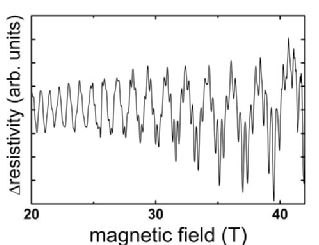Paul Goddard
Fermi surface transformation at the pseudogap critical point of a cuprate superconductor
The nature of the pseudogap phase remains a major puzzle in our understanding of cuprate high-temperature superconductivity. Whether or not this metallic phase is defined by any of the reported broken symmetries, the topology of its Fermi surface remains a fundamental open question. In a complementary study to our 2021 Nature paperLink opens in a new window, we use angle-dependent magnetoresistance (ADMR) to measure the Fermi surface of the La1.6–xNd0.4SrxCuO4 cuprate. Outside the pseudogap phase, we fit the ADMR data and extract a Fermi surface geometry that is in excellent agreement with angle-resolved photoemission data. Within the pseudogap phase, the ADMR is qualitatively different, revealing a transformation of the Fermi surface. We can rule out changes in the quasiparticle lifetime as the sole cause of this transformation. We find that our data are most consistent with a pseudogap Fermi surface that consists of small, nodal hole pockets, thereby accounting for the drop in carrier density across the pseudogap transition found in several cuprates.
The results are published as
Yawen Fang, Gaël Grissonnanche, Anaëlle Legros, Simon Verret, Francis Laliberté, Clément Collignon, Amirreza Ataei, Maxime Dion, Jianshi Zhou, David Graf, Michael J. Lawler, Paul A. Goddard, Louis Taillefer, and B. J. Ramshaw. Nature Physics 18, 558 (2022).Link opens in a new window
My Research
My research interest lies in the development and understanding of materials in which strong electronic correlations give rise to theoretically or technologically significant properties. These functional materials are not merely of concern to condensed matter physicists, they are also relevant for society as a whole - the useful materials of the future being those that are just beyond our understanding today.
The properties displayed by functional materials, which could be superconductivity, magnetism, or merely a marked response to external stimuli, are key ingredients for transformative new technologies. Shedding light on how the interesting properties emerge from the interplay between the quasiparticles, the magnetic moments and the vibrational excitations present in these systems thus remains one of the major challenges facing physics today.
Typically I use low temperatures and high magnetic fields, often combined with molecular chemistry and applied hydrostatic pressure, to understand how the structure of these materials relates to their electronic and magnetic properties. More details of this work can be found here.
High Magnetic Fields
The application of high magnetic fields is a powerful method for revealing the often complex behaviour found in functional materials. Not only do magnetic fields couple to conduction electrons and magnetic moments, the key ingredients in a strongly-correlated system, they are also directional, allowing the topology of electronic interactions to be investigated.
 High magnetic fields can be used to access the normal state of high-temperature superconductors and map out the topology of their Fermi surface via either quantum oscillations (as in the example data shown on the left) or angle-dependent magnetoresistance oscillations. Fields can also change the energy level structure of a material and allow excited states to be explored, identify quantum phase transitions, align spins and lift the frustration in low-dimensional magnets, alter the character of quasiparticles in heavy fermion compounds, and reveal hidden order or induce new phases in magnetic or charge-ordered materials.
High magnetic fields can be used to access the normal state of high-temperature superconductors and map out the topology of their Fermi surface via either quantum oscillations (as in the example data shown on the left) or angle-dependent magnetoresistance oscillations. Fields can also change the energy level structure of a material and allow excited states to be explored, identify quantum phase transitions, align spins and lift the frustration in low-dimensional magnets, alter the character of quasiparticles in heavy fermion compounds, and reveal hidden order or induce new phases in magnetic or charge-ordered materials.
To obtain fields in excess of about 20 tesla, one needs to go to specialised facilities. I am a regular user of the Nicholas Kurti Magnetic Field Laboratory in the Clarendon LaboratoryLink opens in a new window at the University of Oxford. Here it is possible to perform measurements of magnetization and resistivity on a variety of novel materials in fields up to 60 tesla and temperatures down to 400 mK. I also make frequent visits to the National High Magnetic Field LaboratoryLink opens in a new window in the United States, and the High Field Magnet LaboratoryLink opens in a new window in the Netherlands.
HereLink opens in a new window is a short article I wrote for the UK Magnetics Society on measuring electronic properties in high fields.
Low-dimensional and Molecular Magnets
Gaining control of the building blocks of magnetic materials and thereby achieving particular characteristics could make possible the design and growth of bespoke magnetic devices. Progress in the synthesis of molecular materials, and especially coordination polymers, represents a significant step towards this goal.
![Room temperature crystal structure of the polymer magnet [Cu(HF2)(pyrazine)2]PF6 polymer magnet](cuhfs2pyz2pf6-structure.png?maxWidth=279&maxHeight=307)
Coordination polymers, like the one shown on the left, are self-organising materials consisting of arrays of metal ions linked via molecular ligands. Here, the choice of initial components dictates the form of the final product, enabling many different polymeric architectures to be obtained. These materials are thus a possible route to successful crystal engineering and, as well as magnetism, a number of functionalities are being actively studied around the world, including gas storage, optoelectronics, and ferroelectricity.
I use high- and low-field magnetometry to understand the balance of competing interactions in low-dimensional magnet systems constructed from organic and molecular building blocks. By working closely with sample growth experts, materials can be studied that are near-ideal realizations of model quantum systems, allowing the predictions of quantum theory to be tested in the laboratory.
Write to
Department of Physics
University of Warwick
Coventry CV4 7AL
United Kingdom
Contact Details
Office
P242
Telephone
+44 (0)2476151775
Fax
+44 (0)2476150897
E-Mail
p.goddard*at*warwick.ac.uk
Publications
A full list of my publications can be accessed here.
Teaching
I currently teach statistical mechanics to 2nd Year undergraduates:
PX284:Statistical Mechanics, Electromagnetic Theory and OpticsLink opens in a new window
and give lectures on semiconductors, magnetism and superconductors to 3rd Years:
PX385: Condensed Matter Physics
Funding
I was the PI on an ERC Consolidator Grant, that ran from September 2016 to February 2022.
This project received funding from the European Research Council (ERC) under the European Union’s Horizon 2020 research and innovation programme (grant agreement No 681260).
I am extremely grateful to the ERC for this funding.

